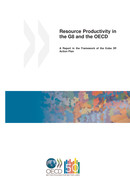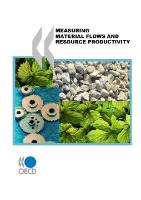Environment
Resource efficiency
Improving resource efficiency is among the top priorities in today’s world, as governments, businesses and civil society are increasingly concerned about natural resource use, environmental impacts, material prices and supply security. The OECD is undertaking a number of projects to inform governments and stakeholders on how to improve resource efficiency. Find out more on the latest developments:
FOCUS: Slovak republic - country study
|
|
Key areas of work
- Circular economy (RE-CIRCLE)
- Cost of inaction and resource scarcity (CIRCLE)
- Extended Producer Responsibility
- Resource efficiency
- Sustainable material management
- Transboundary movements of waste
- Waste and nanomaterials
OECD COUNCIL RECOMMENDATIONS
- Council Recommendation on Resource Productivity (2008)
- Council Recommendation on Material Flows and Resource Productivity (2004)
EVENT
- OECD-UNEP Conference on resource efficiency, 2008, OECD Paris. This multi-stakeholder conference reviewed how improved resource efficiency can reduce the negative environmental impacts of natural resource extraction, materials processing, use and disposal, while securing adequate supplies of materials to sustain economic activity.
REPORTS
 |
Material Resources, Productivity and the Environment, 2015 Improving resource productivity and ensuring a sustainable resource and materials management building on the principle of the 3Rs (reduce, reuse, recycle) is a central element of green growth policies. This report contributes provides a factual analysis of material flows and resource productivity in OECD countries in a global context, and considers the production and consumption of materials, as well as their international flows and available stocks, and the environmental implications associated with their use.
|
 |
Resource Productivity in the G8 and the OECD, 2011 This report responds to a request by G8 Environment Ministers at their meeting in Kobe in 2008 and presents an evaluation of progress on resource productivity. It highlights key trends and main policy developments related to resource productivity in OECD countries, with a particular focus on efforts to implement sustainable materials management. It identifies the main policy challenges and opportunities and discusses the steps that need to be taken to achieve further progress. |
 |
Measuring Material Flows and Resource Productivity: Synthesis Report, Full Guide, The Accounting Framework, and Inventory of Country Activities, 2008 These guidance documents reflect the state of the art concerning experience with material flow analysis and related indicators in member countries. They aim to help achieve greater convergence of already existing initiatives and to facilitate wider dissemination and uptake of existing experience and guidance. Volume I describes the full range of MF approaches and measurement tools, with a focus on the national level and emphasis on areas in which practicable indicators can be defined. Volume II provides a theoretical and technical description of the concepts and methodologies of material flow accounting. Volume III takes stock of activities related to the measurement and analysis of natural resource and material flows in place or planned in OECD countries and in selected non member economies. |
 |
Eco-Efficiency, 2008 This report (i) examines past trends, in order to evaluate the extent to which economic activity is coupled to pollutant releases and resource use; (ii) reviews initiatives to improve eco-efficiency at the firm, community and household level and identifies ways in which governments can provide encouragement and guidance; (iii) evaluates the potential for economy-wide improvements in eco-efficiency and identifies government policies that can help achieve that potential; and (iv) suggests strategies that governments can pursue in partnership through the OECD.
|
CONTACT & SOCIAL MEDIA
- Stay tuned on Twitter: @OECD_ENV
- For more information, please contact: env.contact@oecd.org
- To receive our Environment newsletter, sign up to MyOECD.
Related Documents